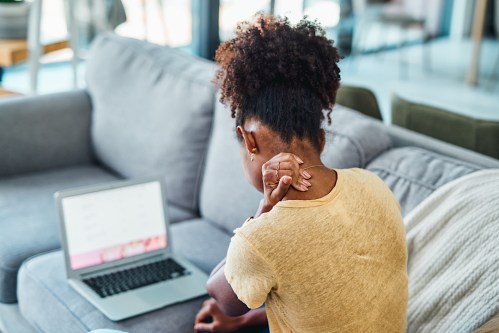If you, like me, spend way too many hours of the day hunched over the computer, you’ve likely experienced neck pain at some point. In which case, you’re going to want to bookmark these methods to release neck pain.
Experts in This Article
massage therapist and lead massage trainer for Massage Envy
Neck pain is, well, a pain in the neck—literally—that can be caused by several things, including stress, bad posture, injuries, and poor sleeping position. Thankfully, many massage techniques can bring some much-needed relief.
Ahead, Juan Gonzalez, massage therapist and president of Massage Envy in Riverside, California, shares five ways to release neck pain.
But first, what causes neck pain to begin with?
There are a few common types of neck pain, according to Harvard Health Publishing. Let’s break them down:
- Muscle pain: This is usually the most common culprit—if you’ve ever done a tough workout using your upper-body muscles, you’ve probably dealt with this form of neck pain. A sore neck and shoulders happen when you’ve taxed these muscles from an exercise sesh or even due to prolonged tension if you sit hunched over at a desk all day.
- Muscle spasm: If you’ve ever experienced a sudden tightening of your neck muscles, you’ve had a muscle spasm in your neck. While there’s no clear cause, it may stem from an injury, a spinal disc or nerve problem, or emotional distress.
- Nerve pain: Feeling a sharp pain and/or that annoying pins and needles sensation can indicate nerve pain, usually caused by the roots of your spinal nerves becoming irritated.
- Headache: A stiff, tender neck accompanied by a dull or aching pain may be caused by headaches.
5 massage techniques to release neck pain
1. Swedish massage
Swedish massage is a popular massage technique that uses long, slow, gentle strokes and kneading motions, Gonzalez says. It is a very relaxing type of massage that helps combat stress and anxiety, too, which is often what causes the neck pain to begin with.
“Being stressed to the point where you are unconsciously contracting your neck and shoulders as part of the fight or flight response can lead to pain throughout the body, but especially in the neck, shoulders, and back,” he says.
If neck pain is something you deal with regularly, Gonzalez recommends getting a Swedish massage every two to three weeks to help reduce pain and increase circulation.
If you don’t have the time or budget to see a professional, he suggests giving yourself a neck massage to help reduce tension and pain.
“Start by placing your fingers on the base of the skull and upper neck and apply light to firm pressure,” he says. “Then, glide your fingers down along the neck toward the upper back. Additionally, do this to your shoulder using the same gliding technique, starting from the upper back toward the clavicle. This can be done with or without a massage medium [such as] lotion, oil, or balm.” (You can also employ some face yoga moves or more general face and neck exercises.)
2. Trigger point therapy
If you get muscle knots in your neck often, trigger point therapy may be a technique worth trying for pain relief.
“A trigger point is a hyperirritable spot, a tight lump found mainly in the muscle belly, commonly known as muscle knots,” Gonzalez says, adding that trigger point therapy can be painful since it involves applying pressure to those sensitive areas to alleviate the pain. So, the recommended frequency comes down to your sensitivity to pain.
Ready to give it a go? Gonzalez instructs you to identify your trigger first and then apply direct firm pressure to a 50 percent comfort level. Hold for 10 seconds. “Then increase pressure to about 75 percent and hold for another 10 seconds,” he says. “The constant maintenance of pressure causes the trigger point to relax.” You can also use a trigger point tool such as a tennis ball or a trigger point hook, which helps with hard-to-reach areas. Repeat until you feel relief.
3. Myofascial release
“Myofascial release massage focuses on loosening up the myofascial—[the] connective web-like tissue that envelops our muscles and every muscle fiber—through manual pressure, kneading, and movement to ease tension,” Gonzalez explains.
There are different ways to do myofascial releases, such as using foam rollers or lightly stretching the joints, muscles, or the skin itself. Gonzalez adds that cupping is also considered a form of myofascial release because it lifts the skin separating the fascia between skin and muscle, which prevents the muscle from moving freely.
To try it at home, Gonazlez recommends using your hands or a trigger point tool to apply pressure to the upper back and/or shoulders at about 50 percent of your comfort level. Do some slow and gentle neck movements such as turning your head left and right and bending the neck left and right and up and down as you do this. Go for about 10 seconds, and repeat the steps until you feel relief.
4. Hot stone massage
Hot stone massages incorporate smooth, flat, heated stones into the treatment, which can also help release neck pain.
“Heat, in general, will better relax the muscle and fascia, providing increased pliability of the skin and muscle,” Gonzalez says. “This is a very soothing technique that can increase blood flow, ease tension, and help reduce pain.”
This type of massage may not be the best if you have certain health conditions, specifically skin conditions like cancer, burns, psoriasis, eczema, or acne, so be sure to check with your doctor before trying it out.
For a quick, at-home version, Gonzalez recommends heat therapy which involves applying a heating pad to the neck area.
5. Assisted stretch therapy
Stretching also does the neck good, hence why Gonzalez suggests the assisted stretch therapy massage technique.
“The focus of this is to lengthen the muscles, which can become shortened over time through lack of activity or activities done with improper body mechanics,” he says. “I’ve seen that happen with athletes quite a bit or for people who have a lot of repetitive movements. So stretching with a therapist to lengthen the muscle across the joints and the extremities can enhance proper movement.”
If you have any injuries, such as from car accidents or athletic injuries, remember to check with your doctor before participating in an assisted stretching session or any other massage treatment.
While having a stretch session with a pro is the most effective, Gonzalez recommends making stretching a lifestyle and doing it daily at home. When doing so, he emphasizes that the neck area is a very sensitive part of the body. So be sure you perform neck stretches slowly and gently, and there should be no pain.
Here are some head, neck, and shoulder stretches to get you started:
How to prevent neck pain
Because one of the most common causes of neck pain is bad posture, per Harvard Health Publishing, working to improve it can go a long way in preventing neck pain from occurring (or reoccurring). Notice how you sit at your desk, when you watch TV, when you read, and when you lie down. If you’re constantly hunched over, strengthening your neck, shoulder, abdominal, and back muscles can help fix your posture. (These exercises to fix your posture can seriously help!)
You can also try a neck decompression method using a mat and a foam roller (or a rolled up towel) that only takes three minutes to do.
FAQ
1. How should I sleep if my neck hurts?
Sleeping on your side or on your back is best for neck pain, according to Harvard Health Publishing. Using a specific pillow for neck pain can also come in handy. A soft—yet supportive—pillow a soft pillow that bolsters the natural curve of your cervical spine, like a cervical pillow or memory foam one, is your best bet.
2. What is the fastest way to relieve neck pain?
Aside from the massage techniques above, it’s a good idea to ice your neck to reduce inflammation early on, according to Harvard Health Publishing. After a day or two, apply heat to relax your neck and improve circulation.
3. Why isn’t my neck pain going away?
If your neck pain seems to be sticking around, you have have arthritis, an infection, or a compressed nerve, per Harvard Health Publishing. Make an appointment with your doctor for neck pain that lasts for weeks or months, limits your motion, spreads down into your shoulders, or causes weakness or numbness.
Sign Up for Our Daily Newsletter
Get all the latest in wellness, trends, food, fitness, beauty, and more delivered right to your inbox.
Got it, you've been added to our email list.











